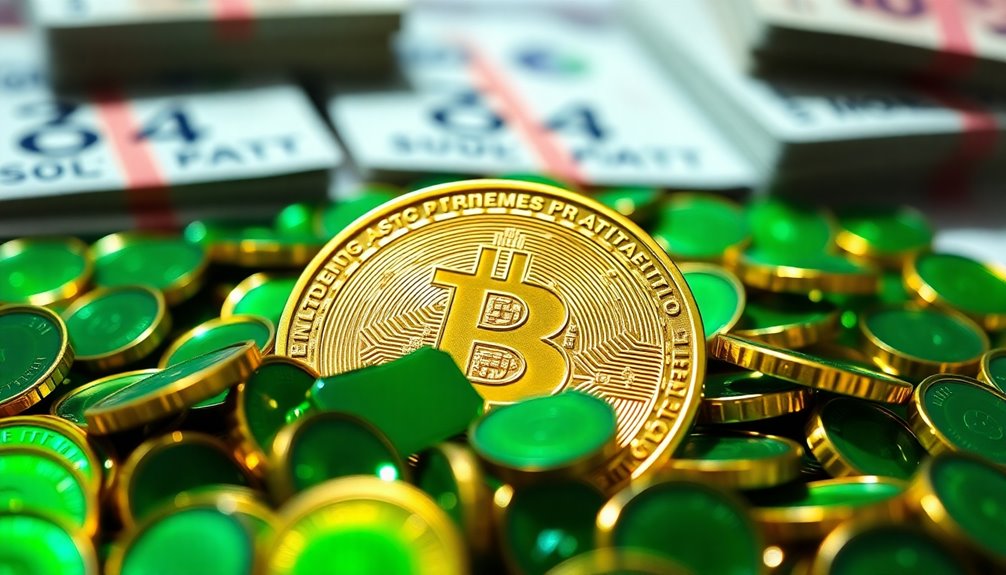Fiat currency plays a vital role in the cryptocurrency landscape by ensuring liquidity and stability. It establishes a benchmark for valuing digital currencies and shapes the regulatory frameworks that govern crypto markets. Whenever you trade cryptocurrencies, you're usually converting from a fiat currency, which facilitates easier transactions and provides a sense of security against crypto's inherent volatility. Central banks' actions regarding fiat can influence the crypto landscape significantly, making an understanding of fiat dynamics essential for your investment strategies. There's more to discover about how this relationship impacts your crypto ventures and overall financial approach.
Key Takeaways
- Fiat currency serves as a benchmark for valuing cryptocurrencies, providing a basis for price comparisons in the market.
- Regulatory frameworks governing fiat directly influence cryptocurrency markets, shaping compliance and operational guidelines for digital assets.
- The integration of fiat into cryptocurrency exchanges enhances liquidity and stability, facilitating smoother transactions and trading activities.
- Central banks' monetary policies affect fiat supply, which in turn impacts cryptocurrency market volatility and investor confidence.
- The reliance on fiat for stablecoins addresses the volatility of cryptocurrencies, offering users a more predictable digital currency alternative.
Fiat Currency Fundamentals

Fiat currency serves as the backbone of modern economies, representing money that's declared legal tender by governments. The term "fiat" comes from Latin, meaning "let it be done," and it signifies a shift from commodity-based systems. First used in 13th century China, fiat became prominent in the 20th century, especially after 1971 when President Nixon ended the US dollar's convertibility to gold. Unlike commodity money, fiat isn't backed by tangible assets. Its value relies on supply and demand, trust in the issuing government, and regulation by central banks. Fiat money's historical evolution demonstrates how societies have adapted their monetary systems to meet changing economic needs.
These institutions control the money supply, implementing monetary policies that stabilize the economy, allowing for flexibility and efficient market operations.
Fiat's Influence on Crypto Markets
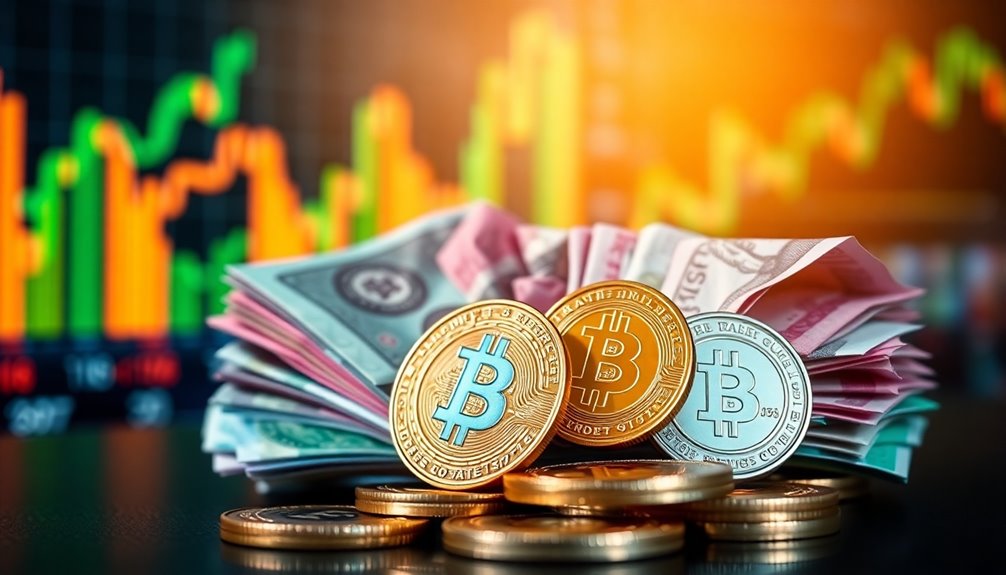
Fiat currencies, backed by central governments, shape the regulatory frameworks governing cryptocurrencies, often leading to stringent scrutiny. This lack of legal tender status for crypto can create gaps that criminals might exploit, emphasizing the need for robust regulations. Central banks' monetary policies face challenges due to the rise of cryptocurrencies, complicating inflation control and economic stabilization. The volatility of cryptocurrencies contrasts sharply with fiat stability, urging the development of stablecoins. Furthermore, the decentralized nature of cryptocurrencies introduces complexities that traditional fiat systems are not equipped to handle. Ultimately, the interplay between fiat and crypto promotes innovation but also necessitates careful regulatory considerations to ensure market stability and protect financial systems.
Currency Exchange Mechanisms

Understanding currency exchange mechanisms is crucial for navigating the global financial landscape, especially as they influence everything from trade to investment strategies.
Exchange Rate Mechanisms (ERM) help countries manage their currency strength, stimulating international trade and balancing domestic currency against global currencies. Central banks play a key role, influencing currency prices and stabilizing exchange rates to reduce volatility. The European Exchange Rate Mechanism aims to reduce exchange rate variability among EU member states, supporting the stabilization of the euro.
Fixed exchange rate regimes provide stability by tying a currency to a more stable one or gold, aiding in inflation control. Alternatively, adjustable peg rate systems, like China's yuan, allow for market fluctuations while maintaining a target peg.
The European Exchange Rate Mechanism (ERM II) furthers this goal, keeping currency fluctuations within set margins, promoting monetary stability throughout Europe.
Pros and Cons of Fiat

Navigating the complexities of currency exchange mechanisms leads to a better understanding of the role of fiat currency in the global economy.
Fiat currency offers significant advantages, like economic flexibility, allowing governments to adjust money supply and respond to market changes. Its universal acceptance simplifies transactions, eliminating barter complexities. Additionally, central authorities can manage inflation and foster growth, creating stability. This management relies heavily on the government's full faith and credit, which underpins the value of fiat money.
However, fiat has drawbacks too. It's susceptible to inflation if too much currency is issued, risking purchasing power. Lacking intrinsic value, its worth relies solely on public trust. Furthermore, economic or political instability can lead to devaluation, making mismanagement a critical concern.
Balancing these pros and cons is essential for grasping fiat's influence in today's financial landscape.
Fiat vs. Crypto Stability
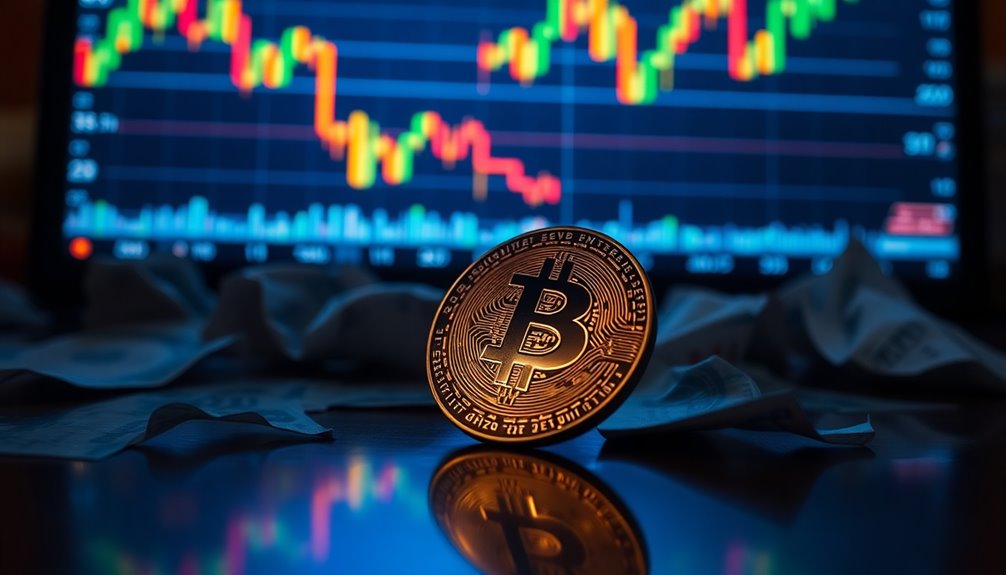
When comparing the stability of fiat currency and cryptocurrencies, it's clear that they operate under vastly different frameworks.
Fiat currencies generally offer more stability due to their ties to government and economic health, aided by central banks regulating money supply and interest rates. While these currencies can face devaluation, changes in value tend to be gradual, allowing time for adjustment. Additionally, fiat currencies are subject to government regulation, which helps maintain their trustworthiness and stability.
In contrast, cryptocurrencies are notorious for their price volatility, with values swinging dramatically in short periods. This instability stems from their decentralized nature and lack of regulation.
Although stablecoins aim to provide a stable alternative, they still face challenges that can lead to fluctuations, making them less reliable than traditional fiat currencies in terms of stability.
Regulatory Compliance Issues

As cryptocurrencies continue to gain traction, the regulatory compliance landscape becomes increasingly complex. Without a centralized authority, tracking transactions and identifying parties involved is a challenge. The decentralized nature of blockchain technology further complicates these efforts, as it allows users to engage in peer-to-peer transactions without intermediaries.
Governments struggle to keep pace with advancements, leading to unclear guidelines for financial institutions. This regulatory gap fosters illicit activities like money laundering and terrorist financing. The higher degree of anonymity offered by cryptocurrencies complicates AML and KYC processes, making compliance nearly impossible on permissionless blockchains.
As a result, financial crime risks rise, prompting regulators to enhance supervision and enforcement. Furthermore, global exchanges often evade national regulations, necessitating coordinated global standards to ensure safer crypto environments.
You'll need to stay informed as these issues evolve, impacting your transactions and investment strategies.
Digital Dollar Initiatives
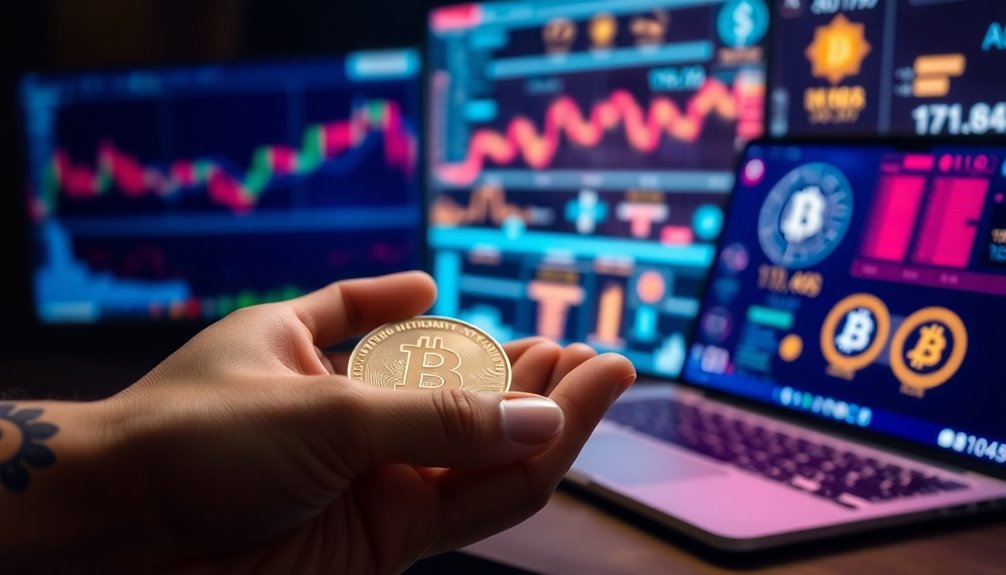
With the rise of digital currencies, initiatives like the Digital Dollar Project (DDP) are crucial in shaping the future of the U.S. The DDP serves as a non-profit forum focused on exploring digital innovation in money and future-proofing the U.S. Dollar.
While it doesn't advocate for the immediate deployment of a U.S. CBDC, it encourages principled leadership in digital currency standard setting. By convening diverse stakeholders—from private sector leaders to policymakers—the DDP informs national policies regarding a digital dollar.
Its recent global conference highlighted themes like privacy, financial inclusion, and cybersecurity. Through pilot programs, such as the security settlement with DTCC, the DDP demonstrates the potential benefits and implications of a CBDC, paving the way for informed decisions. The DDP also aims to establish international standards for digital currency integration to enhance collaboration among nations.
Diversify Fiat Holdings Strategically
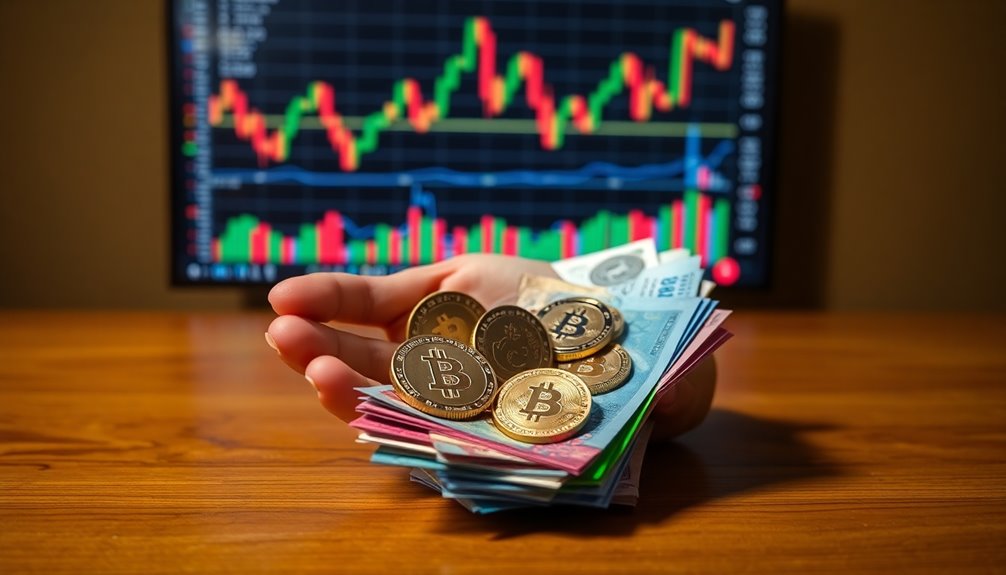
To effectively manage your investments, diversifying fiat holdings strategically is essential for minimizing currency risk. By spreading investments across various currencies, you reduce the potential negative impact of currency fluctuations. A mix of major, minor, and exotic pairs can enhance your portfolio's stability. Geographic diversification also plays a key role, allowing you to mitigate localized economic risks. When choosing currency pairs, consider major pairs for stability, while minor and exotic pairs can offer unique opportunities. Employ hedging strategies and financial instruments like currency ETFs to protect your investments. Understanding correlations between pairs helps in making informed decisions about your holdings. Regularly monitor and adjust your holdings to adapt to market volatility. This disciplined approach helps you navigate global economic trends and maintain a robust investment portfolio.
Frequently Asked Questions
How Does Inflation Affect Fiat Currency and Cryptocurrency Investments?
Inflation impacts your investments in both fiat currency and cryptocurrency. As inflation rises, the purchasing power of fiat decreases, making it harder for you to buy goods and services.
In contrast, cryptocurrencies like Bitcoin can serve as a hedge against inflation due to their limited supply. However, you must be cautious, as cryptocurrencies can be volatile and influenced by market dynamics, which adds risk to your investment decisions.
Can Cryptocurrencies Replace Fiat Currencies in the Future?
Imagine a bustling marketplace where traditional cash coins jingle alongside sleek digital wallets.
You'll likely find cryptocurrencies unlikely to fully replace fiat currencies, especially in developed nations with stable systems.
Yet, in lower and middle-income countries, these digital currencies shine as alternatives, offering solutions to financial inefficiencies.
Ultimately, you might see a future where both coexist, blending the reliability of fiat with the innovation of cryptocurrencies for a more inclusive financial landscape.
What Role Do Central Banks Play in Fiat Versus Cryptocurrency?
Central banks play a crucial role in managing fiat currencies. They set monetary policies, adjust interest rates, and control the money supply to stabilize the economy.
You'll notice their decisions directly affect inflation, purchasing power, and growth.
In contrast, cryptocurrencies operate without central authority, relying on decentralized networks. This lack of oversight results in higher volatility and regulatory uncertainty, making central banks essential for maintaining confidence and stability in traditional financial systems.
How Do Global Events Impact Fiat and Crypto Values Differently?
Imagine watching the world unravel as geopolitical tensions rise, sending shockwaves through financial markets.
In such chaos, fiat currencies often falter, losing value like leaves in a storm.
Meanwhile, cryptocurrencies can shine like beacons of hope, attracting investors seeking refuge from instability.
As inflation soars and trust erodes, you find that crypto offers a sense of security, dancing to a different rhythm while fiat struggles to maintain its ground.
Is It Safe to Hold Fiat and Crypto Simultaneously?
Holding fiat and crypto simultaneously can be safe, but it comes with risks. You need to stay aware of market volatility and liquidity challenges that can impact your investments.
Diversifying your portfolio is smart, but remember that concentration in a few assets can lead to significant disruptions. Always follow regulatory guidelines to protect yourself from scams.
Conclusion
In conclusion, fiat currency plays a crucial role in the cryptocurrency landscape. Did you know that over 90% of Bitcoin trades involve fiat currencies? This statistic highlights how intertwined these two systems are. While fiat offers stability and regulatory backing, it also faces challenges that cryptocurrencies aim to address. As you navigate this evolving space, understanding the dynamics between fiat and crypto can help you make informed decisions and diversify your investments effectively.
